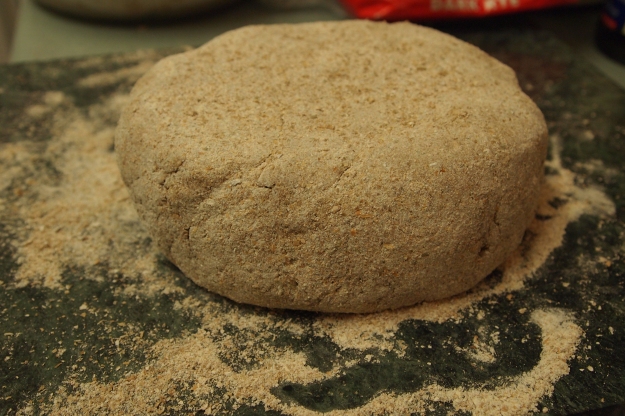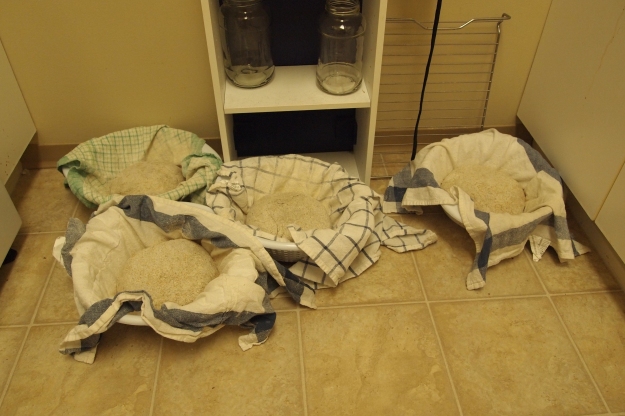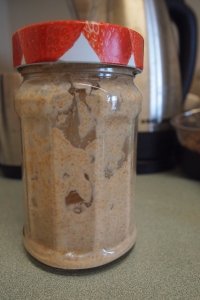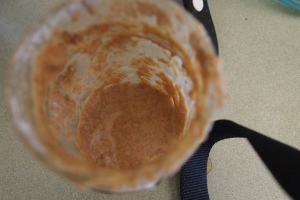
So your bread dough is risen and already looks delicious. Now it is time to bake!
[If it doesn’t have this even crackle to it – try leaving it longer to rise. If you leave it a while and it still isn’t very crackly or there are just a few large cracks then next time try stirring and manipulating it less. Too much water or a not fully developed starter ( the bread will get better and better the longer you have and feed the starter) can also contribute to a less appealing result. Whatever it looks like – BAKE IT. Odds are it will taste good, even if it might not look perfect.]
Check your oven rack(s). One should be in the centre position. If you have more than one rack put the second on the lowest level. Heat the oven to at least 450 F.
Traditional bread, like this, is often baked in fire ovens – so hotter is better. The key is to get to know your oven. Gas ovens often run hotter than electric ovens. I have an electric oven so I try to get mine pre-heated as hot as possible (setting it at 475 F).
If you are concerned about your bakeware or burning the bread then just don’t preheat the oven quite so high – bake at a lower temperature for longer – my first time with this bread I baked one loaf for 50 minutes at 425 F. But I use the higher temperature consistently now because the results are better.
Take out your baking pans. I often use 8 x 8 inch cake pans, and cookie sheets. This last time I also tried a deep, glass, pie pan with a lid. Corning ware might also work. Apparently Dutch ovens are great for bread baking but I don’t have one. And I get such good results with a different technique that I don’t intend to invest in one any time soon. If you only have one pan or two and you are making more then one or two loaves just reuse the pans. I suggest putting no more than 2 loaves in a regular-size or apartment size oven. I do two bakes for 4 loaves. I have also done 2 bakes for 2 loaves.
I line my metal pans with parchment paper. It is a really good investment if you bake even a few times a year and is outstanding for a beginning baker. It makes sure your bread ( or other baked good) doesn’t stick to the pan, and has the added bonus of preventing the bottom of your bread from getting too dark (always a problem with dark non-stick pans). It also has the added benefit of preserving your pans from getting stained and icky and makes clean up a breeze. I resisted getting it for a long time – do it! – it’s totally worth it.
Now flip your bread out of the “bannetons” into your hand and peel off the tea towel. (If it sticks a bit, patch it up and spread a bit of the flour from the rest of the loaf over it. And next time use more flour on your cotton cloth.) Place the bread onto/into your baking pan – crackly side up. 🙂 You’ll notice the surface of the bread it quite dry which means yummy, chewy crust!
For the best crust results you need steam! This is a very simple thing to create or capture. The original recipe suggests covering the bread for the first half of the baking time. I tried using a lid on one loaf but forgot to take it off during baking – If I do it right next time I’ll update you on my results compared with my usual technique: taking an extra oven safe pan (I use a loaf pan as my baking sheets tend to warp), placing it on the bottom rack and letting it get very hot and pouring cold water onto it right after I slide my bread in. I have also taken a cold pan and placed it in the oven and added boiling water from a kettle. The goal is having a steamy oven to bake your bread in. If you only have one rack just put the container you are pouring water in on the same rack as the bread. Experiment and find a way that works for you and your oven: Go to it sir! and share please!
So place your bread in the oven, create some steam and close the door. And try not to open it again for a long while. At this point I turn down my oven to 450 F and let it bake for about 35- 40 minutes.
The first couple of times I baked this bread I found it incredibly difficult to know exactly when the bread is perfectly done. I knew I should see that the cracks in the loaves were dry and the edges of those cracks should have turned golden brown. But through the glass window in my oven it is very hard to see this; especially as the loaf is dark in colour to begin with. So I did some research online and found out that the internal temperature of the loaf should be 200 – 205 F. So, when baking, I put my trusty meat thermometer to use. Though my model only goes up to 194 F, if I leave the bread in the oven for 3-5 minutes after it reaches 194 F then I know I’m set. I usually pop the thermometer in one loaf at the 30 minute mark. At this time, I often rotate my loaves as my oven is small and it is always hotter towards the outside edges. Measuring internal temperature like this can give you confidence that it is completely finished baking and will be fully cooked inside as well as outside. If you don’t have a thermometer then looking for the dry cracks and browning on the bottom and at the edge of the cracks works. There is the knocking technique as well – If your bread is done you can knock on it and if it sounds hollow it is done ( please try not to burn yourself!). If you have to open the oven often in the last 10 minutes or so then do it. It will extend your baking time but it is a good way to learn. Another way I judge “doneness” is by smell; my whole house gets that wonderful bread-baking smell about 5-10 minutes before I need to take it out of the oven.
This is the result :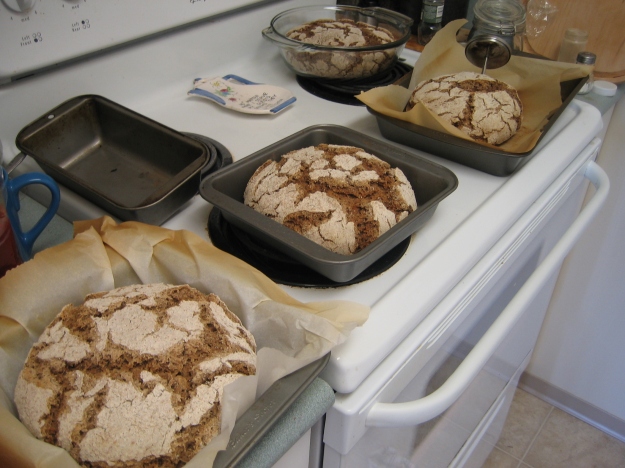
This time I tried a glass pan, and a no parchment pan, and all the loaves turned out wonderfully. So use whatever you have on hand that is oven safe to about 475 F. (You can also spot my thermometer.)
Take the loaves out of the pans right away ( or right after you take a picture 🙂 ) And place on rack of some sort. I use the rack that came with my roasting pan – I have also used wok racks and such. Find a way for cool air to circulate around the bread, and prevent condensation so you don’t end up with soggy bottoms. Before I had a rack I used rows of leftover, take-out chopsticks on my counter and flipped my bread often. I think the key to baking is to find what works for you in your kitchen. People everywhere for centuries have been baking bread and all sorts of other yummy treats in all sort of different environments and kitchens with a range of tools. I guarantee you that you don’t have to buy fancy gourmet items and tools to get great results. And you don’t need to follow the recipe exactly every time – or even the first time. Small adjustments and creativity can get you the best and most satisfying results.
Speaking of results:

This 100% dark rye bread is heavy and healthy and incredibly yummy! I suggest baking as much as you can handle and fit in your freezer. The loaf will last on the counter for days and freezes incredibly well. Just take it out a few hours before you want to eat it. I suggest a good serrated knife for cutting.
ENJOY!!
(As for the starter you can continue to feed it every 24 hours, or even 12 hours, or you can refrigerate it until a few days before you want to bake again – revive it by taking out half and adding flour and water. It will spring right back to life!)


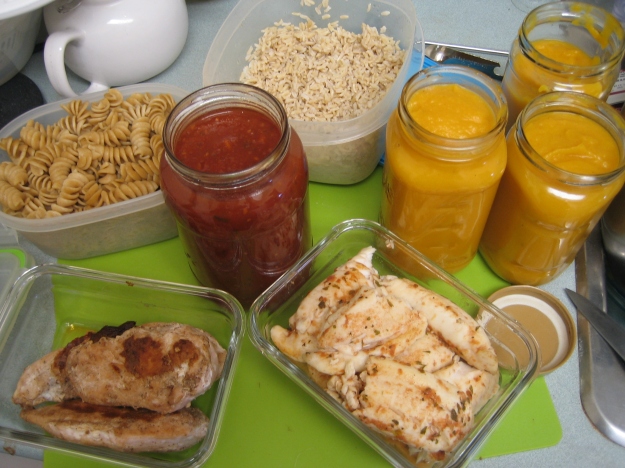
![IMG_0065[1]](https://baroquegoddess.files.wordpress.com/2013/05/img_00651.jpg?w=625&h=468)











